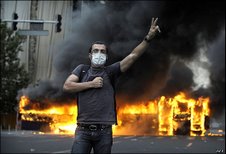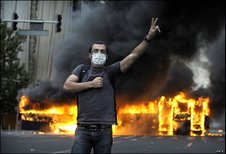From Moldova to Motrin Moms, Twitter has become the arena of coordinated, widespread revolution several times over the last year. Still, when we look back on how the microblogging platform has evolved into a low-barrier tool for grassroots organizing, these will only be footnotes to the events of the last few days in Tehran. As protestors took to the streets of Iran to voice their discontent with the 2009 presidential election results, people from around the world were attentively watching updates from the ground on Twitter, long before hearing reports from any major news outlets.
 The collection of status updates on Twitter provided the world an inside look on the dire situation within Iran from firsthand accounts, each message deeply personal and compelling to a worldwide audience. But when the masses turned to their favorite cable news network for more information, they were met with Mike Huckabee talking about credit cards or other irrelevant programming. With no recognizable coverage in mainstream media as events unfolded, it led users to cry foul on the news networks, demanding more information than 140 characters could deliver.
The collection of status updates on Twitter provided the world an inside look on the dire situation within Iran from firsthand accounts, each message deeply personal and compelling to a worldwide audience. But when the masses turned to their favorite cable news network for more information, they were met with Mike Huckabee talking about credit cards or other irrelevant programming. With no recognizable coverage in mainstream media as events unfolded, it led users to cry foul on the news networks, demanding more information than 140 characters could deliver.
Among the many Twitter-fueled stories from the event, the one that impacts media coverage the most may be how this backchannel removed the mainstream filter to display an amalgamated concept of the news. It gave the masses – first inside Tehran and then across the world – a crude and easy way to drive the issues that concerned them to the top of the marketplace of ideas.
The crowd felt a sense of entitlement for news they wanted covered, and it left the media world playing defense to users who had turned the trending topics sidebar on Twitter’s home page into their own headlines; a user-generated “above the fold” that reflected the group’s dissatisfaction through leads like #CNNFail. Twitter became the instant ombudsman for the media establishment, holding media accountable for what they were – or were not – broadcasting.
The members of the news desk, as well as PR professionals with a vested interest in its agenda, must face the fact that the pulse is beating within a crowd that has tools at their fingertips to easily express their thirst for a certain story. Whether a global issue like the Iranian elections or a local story, communicators must now adapt to provide insights that will smooth the edges and shine the news called for by the crowd.
David Almacy (@almacy) is an SVP and Dave Levy (@LevyDR) is an AE, both with the digital public affairs team at Edelman in Washington, DC. This post is also available on Dave Levy’s blog Most Likely to Die Alone. Original Source: PRWeek (subscription required)


Astrid Sheil, PhD
Could the timing of this situation be any more poignant? After last week’s Academic Summit in Washington, DC, which focused on the power of micro-media and the un-bounding of information and news, the situation in Tehran really demonstrates that a new paradigm in communication has taken hold in the world. We can talk about it all day long, but the people of Iran are showing us how it’s done. In Latin, we say: res ipsa loquitor: the thing speaks for itself.